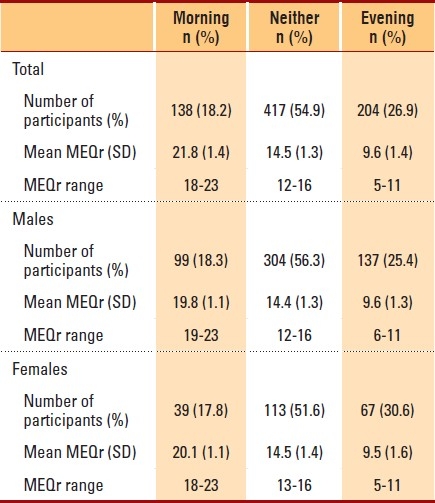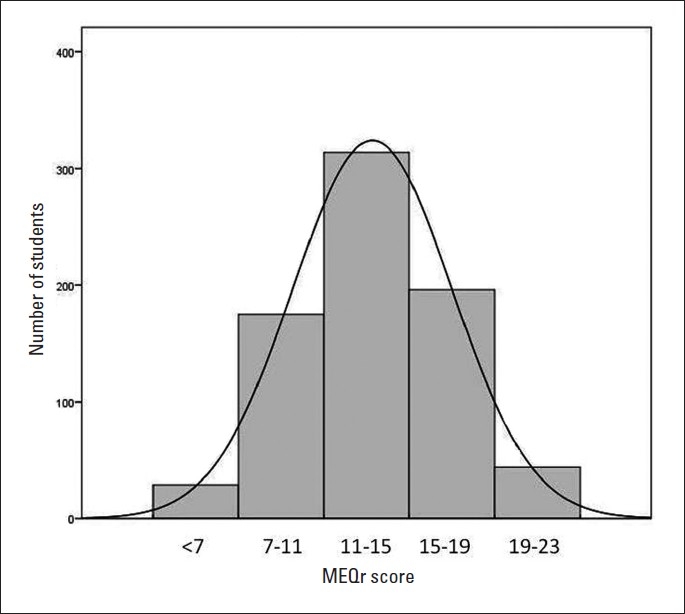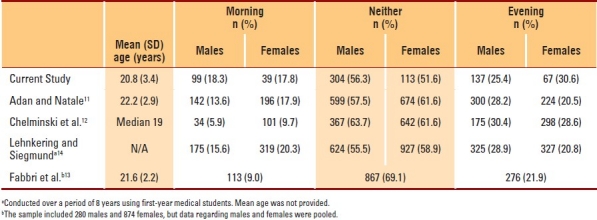Abstract
BACKGROUND AND OBJECTIVES:
There are no published data on the chronotypes of young Saudi adults. This study assessed the distribution of chronotypes in college-aged Saudis.
DESIGN AND SETTING:
Cross-sectional survey of college students
PATIENTS AND METHODS:
A validated abridged version of the original Horne and Ostberg morningness-eveningness questionnaire (MEQr) was used to assess the chronotype of 759 subjects.
RESULTS:
Of 540 (71.1%) males and 219 (28.9%) females participated in this study ( age range, 18-32 years), 138 (18.2%) were “morning-types” 417 (54.9%) were “neither-types” and 204 (26.9%) were “evening-types”. There was no significant gender difference in MEQr typology. In Saudis, particularly males, the frequency of morning typology was somewhat higher than that reported for individuals in similar age groups in some Western countries.
CONCLUSION:
Most Saudi college students had no preference for morningness or eveningness and were classified as “intermediate-type”. Morningness appears to be slightly more common in Saudis, especially males, than in individuals of some Western societies.
The human body has a 24-hour rhythm of sleep and wakefulness, known as a circadian rhythm. Many physiological functions in the body, such as hormonal secretion, maintenance of body temperature, heart rate and blood pressure, exhibit systematic variations in phases aligned with this circadian rhythm. The terms “chronotype” or “morningness-eveningness” are used to describe individual differences in sleep-wake patterns. Individuals who go to sleep early, get up early, and feel and perform better in the morning are classified as morning-types; individuals who go to bed late, wake up late, and perform better in the afternoon are classified as evening-types.1
Although the term “circadian” was first used in the late 1950s, the first questionnaire to evaluate individual chronotypes was introduced in the year 1900.2 Since that time, a number of questionnaires have been developed to assess the morningness-eveningness of human subjects. The Horne and Ostberg morningness-eveningness questionnaire (MEQ) is currently the most widely used tool for identifying individual chronotypes and physiological correlates of circadian rhythmicity in diverse cultures.3 The MEQ has been criticized for its excessive length (19 questions), and a reduced version (MEQr) has been developed that has only 5 questions.4–6
A number of studies have evaluated the chronotypes of college-aged students in Western societies, but there are no comparable studies in countries of the Middle East. In particular, there are no published data on the chronotypes of young people in Saudi Arabia. Genetic, social, cultural, ethnic, climatic and environmental factors are known to modify human chronotypes.7 This study using the MEQr aimed to assess the distribution of chronotypes in a large sample of young college-aged Saudis.
PATIENTS AND METHODS
A random sample of Saudi college students participated in this cross-sectional study, which was conducted at King Saud University (Riyadh, Saudi Arabia). All participants were enrolled as students in various faculties of the sciences and humanities. Participation was voluntary, unpaid and anonymous. Random samples of classes in the participating faculties were selected and a random sample of students in each class were interviewed. The study was conducted during February of 2008. None of the participants worked night shifts, and all participants denied medical, psychological or sleep disorders. Participants were asked to complete a study questionnaire that included questions on demography, college of the participant; and the MEQr. A total of 1000 questionnaires were distributed by trained medical students, who explained the study procedure and obtained informed consent. This research was approved by the Ethics Committee of our institute.
We used a validated reduced version of the original Horne and Ostberg morningness-eveningness questionnaire (MEQr).5 The MEQr has been shown to successfully identify human circadian typology in both experimental and applied research.6 Three questions establish the preferred morning wake-up time, evening bedtime and the hour of the day when personal efficiency is maximal. The two other questions evaluate the extent of tiredness within the first half-hour after morning awakening and find out the circadian type to which the respondent considers himself/ herself to belong. The MEQr originally established five behavioral categories: definitively morning-type (score, 22-25), moderately morning-type (score, 18-21), neither-type (score, 12-17), moderately evening-type (score, 8-11) and definitively evening-type (score, 4-7). In the present study, we adopted the simpler classification used by Taillard and colleagues and other researchers: morning-type (M-type; score, 18-25), neither-type (N-type; score, 12-17) and evening-type (E-type; score, 4-11).5,6,8,9
Two bilingual physicians independently translated the original version of the questionnaire from English to Arabic. Two other bilingual physicians who had no knowledge of the original version of the questionnaire back-translated these drafts to English. The translations were reviewed in collaboration with the translators, and the back-translation was assessed for equivalence to the original English version. Discrepancies between the forward- and back-translation versions were discussed and resolved to produce a final Arabic version. Prior to use in this study, the questionnaire was initially administered to 10 bilingual subjects, who completed both the Arabic version and the English version to determine the test-retest reliability. Circadian typology was independent of version. The MEQr was also initially given to a sample of 20 students to assess the data-gathering process and the legibility of the Arabic version of the questionnaire.
All data are expressed as means and standard deviations, or medians and ranges. A t test was used to compare mean typology scores of males and females, and a chi-square test was employed to compare typologies of males and females. The sample size was chosen to detect a prevalence of 6%, with a confidence interval of 95% and a precision of 5%. The estimated sample size was 722.10 Sigma Stat, version 3.5 (SPSS Inc., Chicago, IL), was used for all statistical analyses.
RESULTS
A total of 759 complete questionnaires were returned (75.9% response rate), including 540 (71.1%) males and 219 (28.9%) females. The median was 21 years and age range was 18-32 years (mean [SD], 20.8 [3.4]; males, 20.8 [3.9] females, 20.9 [1.7]). Body mass index was 20.7 [5.5] and 35.3 [8.5] for males and females, respectively. Table 1 presents the numbers and percentages of males and females as a function of MEQr typology. A total of 138 (18.2%) participants were “morning-types,” 417 (54.9%) were “neither-types” and 204 (26.9%) were “evening-types.” Table 1 also shows the mean and range of MEQr scores for males and females in the 3 groups. There was no gender difference in mean scores or in the frequency of any category (morning-, neither- or evening-type).
Table 1.
Distribution of participants based on the reduced Horne and Ostberg morningness-eveningness questionnaire (MEQr) scores and typology.

Figure 1 shows the distribution of frequency of participants as a function of MEQr typology. MEQr scores ranged from 5 to 23 (mean, 16.3 [4.6]; median, 15.6). The distribution approximates a normal curve, with a skewness of 0.005 and a kurtosis of -0.4. (Table 2) compares the typology distribution of our study participants with that of four participants of other studies that used the MEQ to investigate the status of college students of the same age group in Spain, Italy, Germany and the United States.11–14 Morning typology was more common in Saudis, particularly males, than reported in some Western countries.
Figure 1.

Frequency distribution of MEQr scores (n=759).
Table 2.
Comparison of typology distribution between our study and four other reports.

DISCUSSION
Children tend to have a morning typology, but this tendency changes to an evening typology during puberty, and back to morning typology after adolescence and during adulthood.15 We consider that college students in this study were of post-adolescence age. Our results indicate that most participants had a typology of the intermediate type, which is in agreement with the circadian typology reported in western societies (Table 2). However, morning typology was more common in Saudis, particularly males, than reported for similar age groups in some Western countries.
Our study was not designed to identify factors that influence circadian typology. However, we postulate that waking up each day for Fajr (dawn) prayer may explain the higher prevalence of morningness in our participants. During the study period (February), dawn occurs between 05:00 and 05:15 in Riyadh. We found no significant differences between males and females in our study. Previous reports of gender effects on chronotype have been inconsistent. Some investigators have reported a higher prevalence of morningness in females, but other studies found no between-gender differences.11,14,16 Chronotype has also been reported to be related to personality characteristics. Morning-types have been found to have higher self-esteem, a more internal control locus, and to be more conscientious.17 In addition, evening-types have been reported to suffer from higher rates of depression and anxiety, later mood peaks,4,17 and irregular sleep patterns.18,19 A study of a group of medical students by Medeiros and colleagues demonstrated that evening-types were more likely to present with irregular sleep patterns and lower academic performance.20
This is the first study of the distribution of chronotypes in young Saudi adults. Most individuals had no special preference for morningness or eveningness, and we classified them as “neither-” or “intermediate-type.” In addition, morningness, particularly in males, appeared to be more common among our participants than in the cohorts explored in some Western societies. We suggest that future studies examine the circadian typology of individuals in different age groups and the factors that influence morningness-eveningness of Saudis and other people of the Middle East.
Acknowledgments
This study was supported by a grant from the University Sleep Disorders Center, King Saud University and King Abdulaziz City for Science and Technology.
REFERENCES
- 1.Kerkhof GA. Inter-individual differences in the human circadian system: A review. Biol Psychol. 1985;20:83–112. doi: 10.1016/0301-0511(85)90019-5. [DOI] [PubMed] [Google Scholar]
- 2.Horne JA, Ostberg O. Individual differences in human circadian rhythms. Biol Psychol. 1977;5:179–90. doi: 10.1016/0301-0511(77)90001-1. [DOI] [PubMed] [Google Scholar]
- 3.Horne JA, Ostberg O. A self-assessment questionnaire to determine morningness–eveningness in human circadian rhythms. Int J Chronobiol. 1976;4:97–110. [PubMed] [Google Scholar]
- 4.Chelminski I, Petros TV, Plaud JJ, Ferraro FR. Psychometric properties of the reduced Horne and Ostberg questionnaire. Pers Individ Dif. 2000;29:469–78. [Google Scholar]
- 5.Adan A, Almirall H. Horne and Ostberg morningness-eveningness questionnaire: A reduced scale. Pers Individ Dif. 1991;12:241–53. [Google Scholar]
- 6.Natale, Esposito M, Martoni M, Fabbri M. Validity of the reduced version of the Morningness-Eveningness Questionnaire. Sleep Biol Rhythms. 2006;4:72–4. [Google Scholar]
- 7.Randler C. Morningness-eveningness comparison in adolescents from different countries around the world. Chronobiol Int. 2008;25:1017–28. doi: 10.1080/07420520802551519. [DOI] [PubMed] [Google Scholar]
- 8.Taillard J, Philip P, Bioulac B. Morningness/eveningness and the need for sleep. J Sleep Res. 1999;8:291–5. doi: 10.1046/j.1365-2869.1999.00176.x. [DOI] [PubMed] [Google Scholar]
- 9.BaHammam A. Assessment of sleep patterns, daytime sleepiness, and chronotype during Ramadan in fasting and nonfasting individuals. Saudi Med J. 2005;26:616–22. [PubMed] [Google Scholar]
- 10.Naing I, Winn T, Rusli BN. Practical Issues in Calculating the Sample Size for Prevalence Studies. Arch Orofacial Sci. 2006;1:9–14. [Google Scholar]
- 11.Adan A, Natale V. Gender differences in morningness-eveningness preference. Chronobiol Int. 2002;19:709–20. doi: 10.1081/cbi-120005390. [DOI] [PubMed] [Google Scholar]
- 12.Chelminski I, Ferraro R, Petros T, Plaud JJ. Horne and Ostberg questionnaire: A score distribution in a large sample of young adults. Pers Individ Dif. 1997;23:647–52. [Google Scholar]
- 13.Fabbri M, Antonietti A, Giorgetti M, Tonetti L, Natale V. Circadian typology and style of thinking differences. Learn Individ Differ. 2007;17:175–80. [Google Scholar]
- 14.Lehnkering H, Siegmund R. Influence of chronotype, season, and sex of subject on sleep behavior of young adults. Chronobiol Int. 2007;24:875–88. doi: 10.1080/07420520701648259. [DOI] [PubMed] [Google Scholar]
- 15.Roenneberg T, Kuehnle T, Juda M, Kantermann T, Allebrandt K, Gordijn M, et al. Epidemiology of the human circadian clock. Sleep Med Rev. 2007;11:429–38. doi: 10.1016/j.smrv.2007.07.005. [DOI] [PubMed] [Google Scholar]
- 16.Reyner LA, Horne JA. Gender- and age-related differences in sleep. Sleep. 1995;18:127–34. [PubMed] [Google Scholar]
- 17.Jackson LA, Gerard DA. Diurnal types, the "big five" personality factors, and other personal characteristics. J Soc Behav Pers. 1996;11:273–84. [Google Scholar]
- 18.Park YM, Matsumoto K, Seo YJ, Shinkoda H, Park KP. Sleep in relation to age, sex, and chronotype in Japanese workers. Percept Mot Skills. 1998;87:199–215. doi: 10.2466/pms.1998.87.1.199. [DOI] [PubMed] [Google Scholar]
- 19.Roenneberg T, Wirz-Justice A, Merrow M. Life between clocks: Daily temporal patterns of human chronotypes. J Biol Rhythms. 2003;18:80–90. doi: 10.1177/0748730402239679. [DOI] [PubMed] [Google Scholar]
- 20.Medeiros A, Mendes D, Lima P, Araujo J. The Relationships between Sleep-Wake Cycle and Academic Performance in Medical Students. Biol Rhythm Res. 2001;32:263–70. [Google Scholar]


